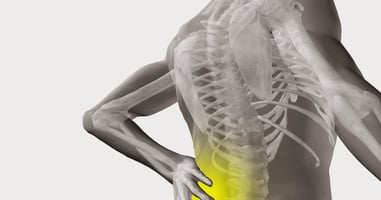Chronic abdominal pain in childhood may forecast not only a long-term predilection to anxiety, but...
Treating Chronic Pain Starts With Patient Education

According to the U.S. Centers for Disease Control and Prevention, more than 50 million adults in the United States experienced chronic pain (pain lasting three or more months) in 2021. Such pain is known to increase the risk of depression and anxiety. In a packed session yesterday at APA’s Annual Meeting in San Francisco, Xavier Jimenez, M.D., the director of psychiatry at Long Island Jewish Medical Center, offered pointers to psychiatrists on how best to talk with patients about their chronic pain and help them get on board with treatment.
Psychiatrists are typically “adept at psychopharmacology, and much of chronic pain management is applied psychopharmacology, including detoxification,” Jimenez explained to the audience. “We also have psychotherapeutic skills that are highly relevant in the [chronic pain] space.” For example, psychiatrists are well-positioned to help patients work through changing treatment goals, such as moving from pain relief to improved function.
Jimenez said that psychiatrists should try to determine how physical sensations and emotional reactions combine to create each patient’s subjective experience of pain. These emotional reactions are often a response not only to pain itself, but to the event that led to the pain such as an injury, accident, or surgery, he said. He invited psychiatrists to consider posttraumatic stress disorder (PTSD) as a model for better understanding patients with chronic pain.
“Think of your chronic pain patient who is very hypervigilant about their pain and avoiding different activities or things that activate the pain. They could also have hyperarousal to pain,” Jimenez said. “We see these features time and again in PTSD, and it has been shown in fMRI studies that patients with PTSD and patients with chronic pain but without PTSD have shared neural pathways.”
Educating patients about how chronic pain works can help build rapport and get them on board with approaching their pain from a psychiatric angle. For example, a discussion of central sensitization—an amplification of neural signaling within the central nervous system that elicits pain hypersensitivity—can help patients understand why even a slight touch that would not bother most people is so painful to them.
“Once you open their eyes to the fact that there is more to pain processing than the knee, the back, the foot, and so on, then you can [create treatment] targets, which is where we get into our management strategies,” he said.
Jiminez encouraged psychiatrists to pay heed to signs of catastrophizing in their patients with chronic pain. “This could manifest as someone thinking that their body is falling apart, they’re always going to be disabled, they’re going to die, things of that nature. [Catastrophizing] has been shown in patients with chronic pain and is one of the poorest prognostic factors for a patient,” he said. “It’s an important [psychiatric] target to treat because if you don’t address it, the patient is going to continue to languish.”
Jiminez suggested that psychiatrists become familiar with the Pain Disability Index, which assesses whether patients are completely disabled, partially disabled, or not at all disabled by their pain across seven domains: “It’s a very important conversation starter. For example, you might see someone who is occupationally impaired but they’re not impaired at all on the other domains. That’s a bit of a red flag for malingering,” he said. “Or if you see somebody who’s only sexually impaired but everything else is fine, that may connote some complex relationship issues.”
The Adverse Childhood Experiences (ACEs) questionnaire can also help psychiatrists to gain a better understanding of their patients. “It can open up the conversation for patients to realize that some of the things that happened a long time ago might actually be connected to what’s happening now, and that trauma or adversity [they experienced] as a child or young adult could be catching up with them,” he said. He added that the ACEs questionnaire could lead to a conversation about central sensitization and other neural phenomena that can contribute to chronic pain.
“You can help them understand that there’s something neurobiological that you want to manipulate with your treatments to help them with their pain,” he said. “That is usually more effective than saying you’re going to try to help them with their depression because most people will say ‘Yeah, I’m depressed because I’m in pain.’ So let’s get past that and try to help them with the neurological underpinnings of their pain.”
Look for future coverage of APA’s 2023 Annual meeting in upcoming issues of Psychiatric News.
(Image: iStock/Trifonov_Evgeniy)





